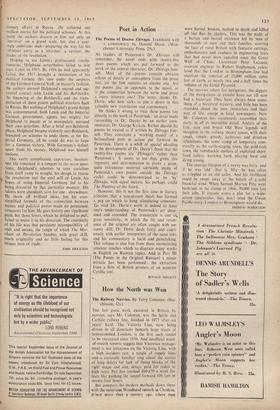How the North was Won
THE last great work executed in Britain by navvies, says Mr. Coleman, was the Settle and Carlisle railway line, finished in 1875 after six years' hard. The Victoria Line, now being driven in all directions beneath large tracts of honeycombed London, is the first such tunnel to be excavated since 1934. And unofficial word- of-mouth reports suggest that Victorian manage- ment is not unknown on the Victoria Line, with a high accident rate, a tangle of supply lines and/ a curiously familiar ring about the stories of long delays for lack of lining blocks of the right shape and size, delays paid for today at high rates. Pay has reached £60470 a week for feats like pushing the tunnel forward 106 feet in twenty-four hours.
But compare the modern methods down there with the notorious Woodhead tunnels in Cheshire, driven more than a century ago, where men were buried, broken, bashed to death and killed off like flies by cholera. This was the nadir of a barren and bestial existence led by tens of thousands of men and their families, scarring the face of rural Britain with fantastic cuttings, embankments and viaducts in engineering feats that had never been equalled since the Great Wall of China. Lieutenant Peter Lecount, assistant engineer to Robert Stephenson, calcu- lated that the London to Birmingham line had required the removal of 25,000 million cubic feet of earth. pr nearly two and a half times the volume of he Great Pyramid.
The navvies (short for, navigators, the diggers of the navigations or canals) have not till now had a historian. They have always been some- thing of a historical mystery, and little has been recorded about the men themselves and their way of life, except in local newspapers. Now Mr. Coleman has assiduously assembled their story, in all its incredible detail. Addicts of the free, easy and brutal Old West legends will recognise in the railway shanty towns, with their tough, simple. greedy, lecherous and drunken inhabitants, the same stamp of temporary com- munity as the cattle-staging town, the gold-rush town, the ramshackle shelters of exploited short- lived toilers, working hard, playing hard and dying young.
The average lifespan of a navvy was forty, and if he was 'old' that is. fifty-- he was often as crippled as an old sailor. And his livelihood could be swept away at the breath of a cold ' financial wind. When Samuel Morton Peto went bankrupt in the slump of 1866. 30,000 men lost their jobs. If anyone wants a plot for a wide- screen spectacular, they don't need the Union Pacific story. London to Birmingham Would do.
ANDREW ROBERTSON


































 Previous page
Previous page